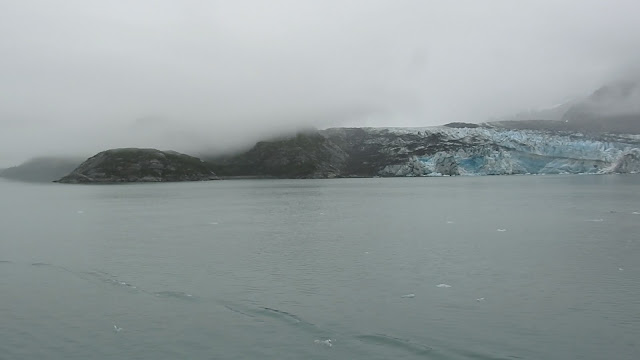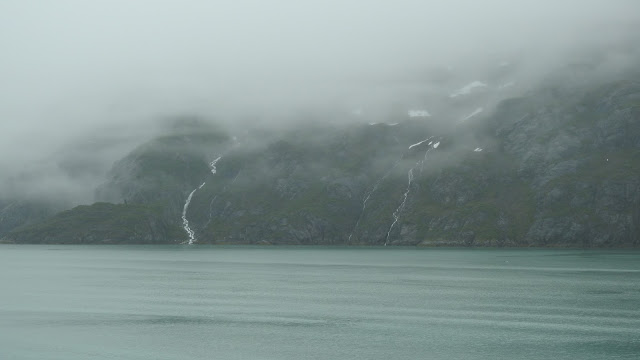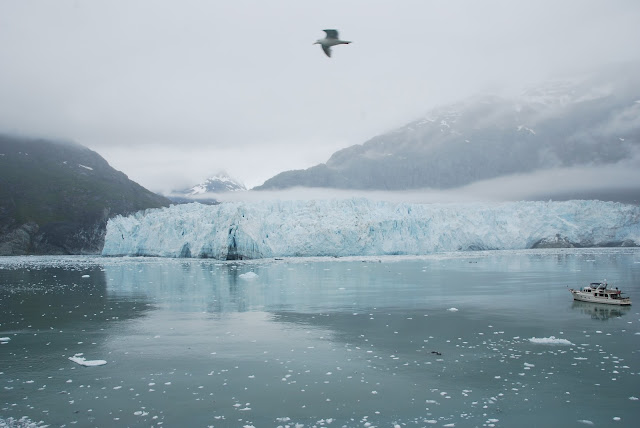Previous | Main | Next | Go to |
🌐 Map
📹 Video
Route: Vancouver, Squamish, Inside Passage, Ketchikan, Juneau, Skagway, Glacier Bay NP, Seward, Alyeska, Anchorage, Talkeetna, Denali, Fairbanks, Valdez.
Places: Icy Strait, Glacier Bay, Glacier Bay National Park, Lamplugh Glacier, Johns Hopkins Inlet, Johns Hopkins Glacier, Tarr Inlet, Margerie Glacier, South Marble Island.
Wildlife & flora: Harbor seal, Black-legged kittiwake, Glaucous-winged gull, Steller sea lion, Otter.
⏳ Jun 30, 2017
Covering 3.3 million acres of rugged mountains, dynamic glaciers, temperate rainforest, wild coastlines and deep sheltered fjords, Glacier Bay National Park is a highlight of Alaska's Inside Passage and part of a 25-million acre World Heritage Site—one of the world’s largest international protected areas. From sea to summit, Glacier Bay offers limitless opportunities for adventure and inspiration.
🌐 Map
Glacier bay
Lamplugh Glacier is an 8-mile-long (13 km) glacier located in Glacier Bay National Park and Preserve in the U.S. state of Alaska. It leads north to its 1961 terminus in Johns Hopkins Inlet, 1.4 miles (2.3 km) west of Ptarmigan Creek and 76 miles (122 km) northwest of Hoonah. The glacier was named by Lawrence Martin of the U.S. Geological Survey around 1912 for English geologist George William Lamplugh (1859–1926), who visited Glacier Bay in 1884.
Johns Hopkins Inlet
Johns Hopkins Glacier is a 12-mile (19 km) long glacier located in Glacier Bay National Park and Preserve in the U.S. state of Alaska. It begins on the east slopes of Lituya Mountain and Mount Salisbury, and trends east to the head of Johns Hopkins Inlet, 1 mile (1.6 km) southwest of the terminus of Clark Glacier and 79 miles (127 km) northwest of Hoonah. It was named after Johns Hopkins University in Baltimore, Maryland in 1893 by Harry Fielding Reid.[1] It is one of the few advancing tidewater glaciers of the Fairweather Range.[2] Access to the face of the glacier is limited to the Johns Hopkins Inlet.
 |
| Harbor seal (Phoca vitulina richardii) hauled out on ice |
 |
| Black-legged kittiwake |
Tarr Inlet



Margerie Glacier is a 21 mi (34 km) long tidewater glacier in Glacier Bay, Alaska, United States within the boundaries of Glacier Bay National Park and Preserve. The glacier begins on the southern slopes of Mount Root, elevation 12,860 feet (3,920 m), on the Alaska–Canada border flowing southeast down the valley, then turning to the northeast toward its terminus in Tarr Inlet. Margerie Glacier is one of the most active and frequently-visited glaciers in Glacier Bay, which was declared a National Monument in 1925, a National Park and Preserve in 1980, a UNESCO World Biosphere Reserve in 1986 and a World Heritage Site in 1992. While most of the tidewater glaciers in the park have been receding over the last several decades, Margerie Glacier has become stable, neither growing nor receding, while Johns Hopkins Glacier is advancing.
Margerie Glacier extends upstream for a length of 21 miles (34 km) from Tarr Inlet to its source on the southern slopes of Mount Root.[2] The width of the glacier is about 1 mile (1.6 km) and the total height at its terminus is about 350 feet (110 m) including 100 feet (30 m) that is underwater.
In 1750, Glacier Bay was a massive single glacier but due to higher average temperatures and lower average snowfall amounts over the last several centuries it has been transformed into what is now a 65 miles (105 km) fjord with many smaller glaciers.[6][7] Margerie Glacier is located at the extreme northwestern end of the bay and is situated perpendicular to the Grand Pacific Glacier.
Glacier Bay and its many glaciers are approachable only by air and water as there are no roads in the park. The steep drop off of Margerie Glacier's terminus allows cruise ships and smaller park tour boats to anchor nearby providing close-up views of ice calving.
Glaucous-winged gull
South Marble Island in Glacier Bay is home to many forms of wildlife, including these Steller sea lions. When I first heard the visiting park ranger aboard the Alaskan Dream talk about Steller sea lions, I thought he was saying they were stunning and remarkable, which of course, they are. That big one in the middle, he made enough noise for all of them.
Otter
Steller sea lion
Previous | Main | Next | Go to |
⏳ Jun 2017








































